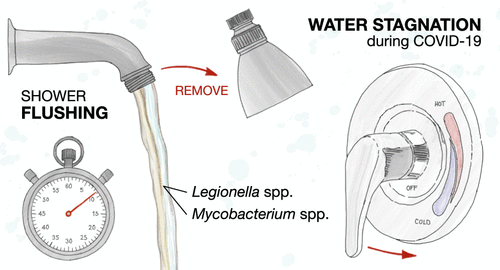当前位置:
X-MOL 学术
›
Environ. Sci. Technol.
›
论文详情
Our official English website, www.x-mol.net, welcomes your
feedback! (Note: you will need to create a separate account there.)
Flushing of Stagnant Premise Water Systems after the COVID-19 Shutdown Can Reduce Infection Risk by Legionella and Mycobacterium spp.
Environmental Science & Technology ( IF 10.8 ) Pub Date : 2020-11-24 , DOI: 10.1021/acs.est.0c06357 Raymond M. Hozalski 1 , Timothy M. LaPara 1 , Xiaotian Zhao 1 , Taegyu Kim 1 , Michael B. Waak 2, 3 , Tucker Burch 4 , Michael McCarty 5
Environmental Science & Technology ( IF 10.8 ) Pub Date : 2020-11-24 , DOI: 10.1021/acs.est.0c06357 Raymond M. Hozalski 1 , Timothy M. LaPara 1 , Xiaotian Zhao 1 , Taegyu Kim 1 , Michael B. Waak 2, 3 , Tucker Burch 4 , Michael McCarty 5
Affiliation

|
There is concern about potential exposure to opportunistic pathogens when reopening buildings closed due to the COVID-19 pandemic. In this study, water samples were collected before, during, and after flushing showers in five unoccupied (i.e., for ∼2 months) university buildings with quantification of opportunists via a cultivation-based assay (Legionella pneumophila only) and quantitative PCR. L. pneumophila were not detected by either method; Legionella spp., nontuberculous mycobacteria (NTM), and Mycobacterium avium complex (MAC), however, were widespread. Using quantitative microbial risk assessment (QMRA), the estimated risks of illness from exposure to L. pneumophila and MAC via showering were generally low (i.e., less than a 10–7 daily risk threshold), with the exception of systemic infection risk from MAC exposure in some buildings. Flushing rapidly restored the total chlorine (as chloramine) residual and decreased bacterial gene targets to building inlet concentrations within 30 min. During the postflush stagnation period, the residual chlorine dissipated within a few days and bacteria rebounded, approaching preflush concentrations after 6–7 days. These results suggest that flushing can quickly improve water quality in unoccupied buildings, but the improvement may only last a few days.
中文翻译:

关闭COVID-19后冲洗死水前提系统可以减少军团杆菌和分枝杆菌属的感染风险。
当由于COVID-19大流行而关闭的建筑物重新开放时,人们担心机会致病菌可能暴露。在这项研究中,在五个空置(即约2个月)的空置大学建筑物中,在冲水淋浴之前,期间和之后收集水样,并通过基于培养的分析(仅嗜肺军团菌)和定量PCR来量化机会主义者。两种方法均未检测到嗜肺乳杆菌。但是,军团菌属,非结核分枝杆菌(NTM)和鸟分枝杆菌复合体(MAC)广泛存在。使用定量微生物风险评估(QMRA),估计暴露于嗜肺乳杆菌的疾病风险通过淋浴的MAC和MAC通常较低(即,每日风险阈值低于10–7),但某些建筑物中由于MAC暴露而引起的全身感染风险除外。冲洗迅速恢复了总氯(作为氯胺)残留量,并在30分钟内将细菌基因靶点降低至建筑物入口浓度。在冲洗后停滞期间,残留的氯在几天之内消失,细菌反弹,在6-7天后达到冲洗前的浓度。这些结果表明,冲洗可以快速改善空置建筑物的水质,但这种改善可能仅持续几天。
更新日期:2020-12-15
中文翻译:

关闭COVID-19后冲洗死水前提系统可以减少军团杆菌和分枝杆菌属的感染风险。
当由于COVID-19大流行而关闭的建筑物重新开放时,人们担心机会致病菌可能暴露。在这项研究中,在五个空置(即约2个月)的空置大学建筑物中,在冲水淋浴之前,期间和之后收集水样,并通过基于培养的分析(仅嗜肺军团菌)和定量PCR来量化机会主义者。两种方法均未检测到嗜肺乳杆菌。但是,军团菌属,非结核分枝杆菌(NTM)和鸟分枝杆菌复合体(MAC)广泛存在。使用定量微生物风险评估(QMRA),估计暴露于嗜肺乳杆菌的疾病风险通过淋浴的MAC和MAC通常较低(即,每日风险阈值低于10–7),但某些建筑物中由于MAC暴露而引起的全身感染风险除外。冲洗迅速恢复了总氯(作为氯胺)残留量,并在30分钟内将细菌基因靶点降低至建筑物入口浓度。在冲洗后停滞期间,残留的氯在几天之内消失,细菌反弹,在6-7天后达到冲洗前的浓度。这些结果表明,冲洗可以快速改善空置建筑物的水质,但这种改善可能仅持续几天。











































 京公网安备 11010802027423号
京公网安备 11010802027423号